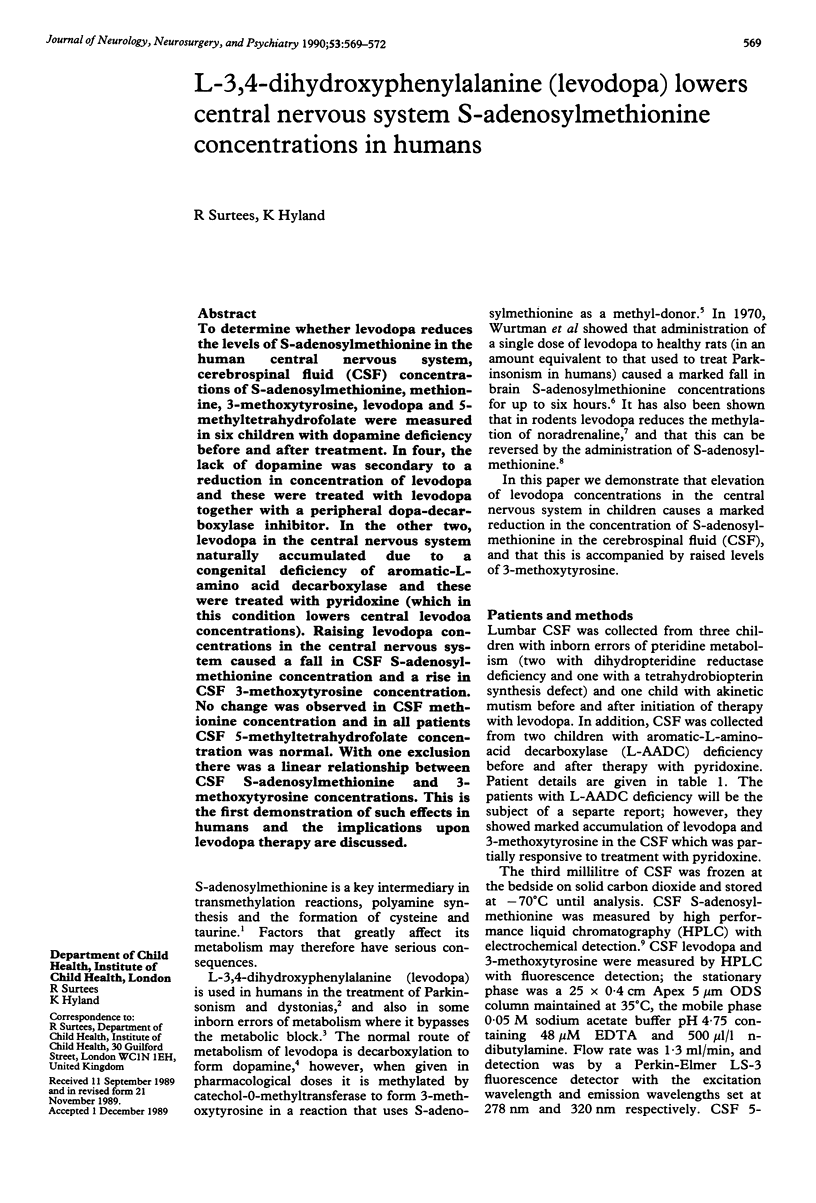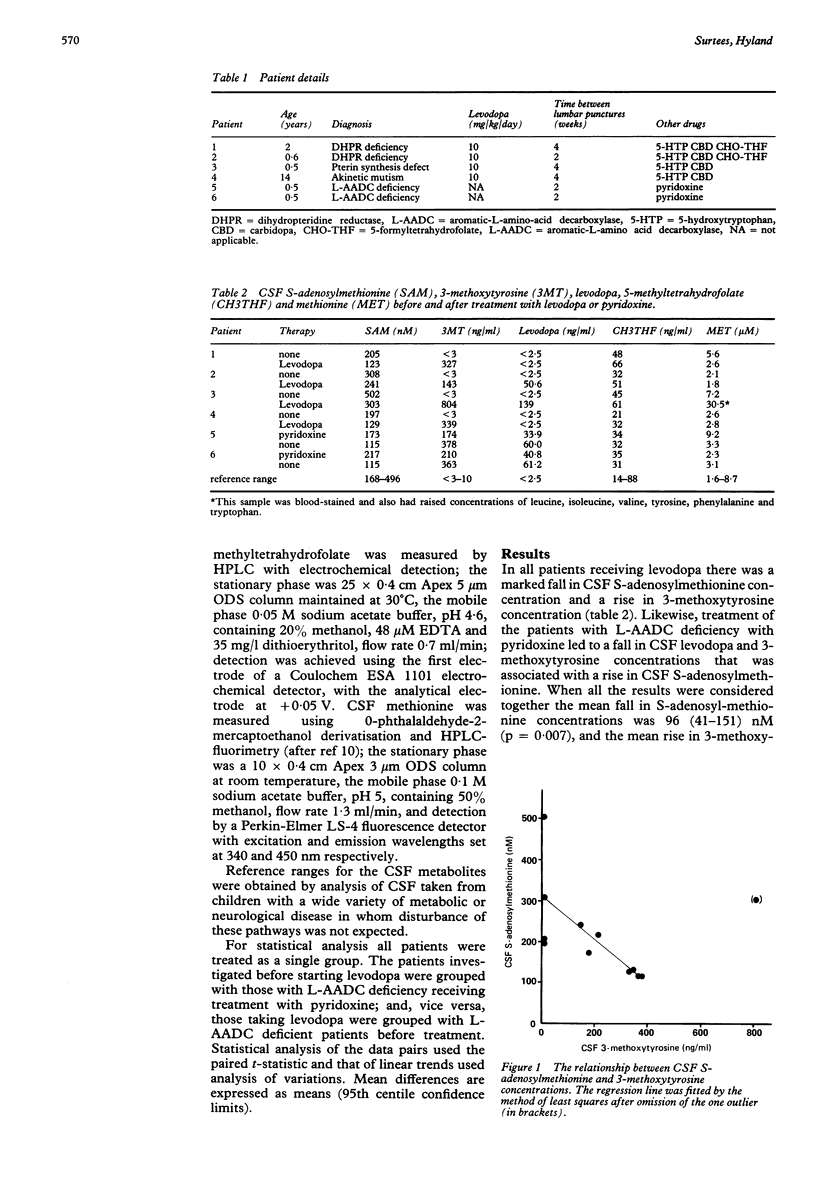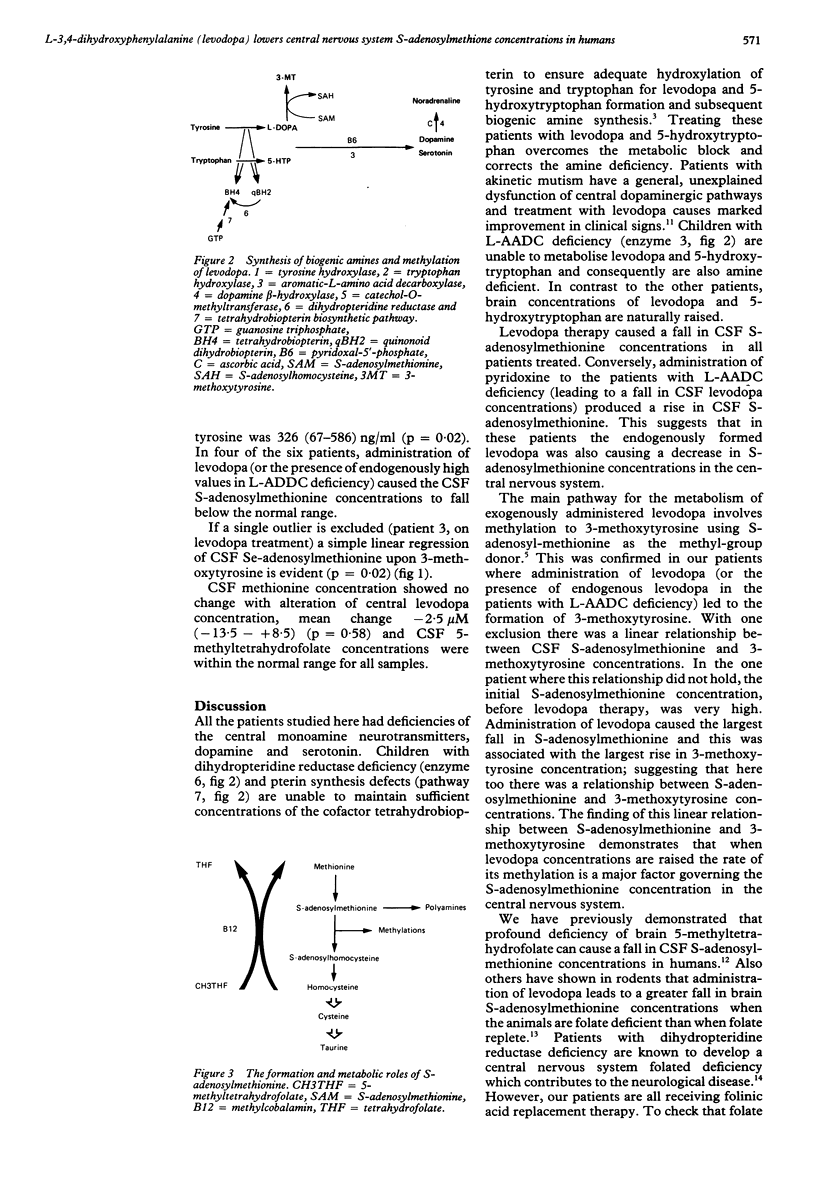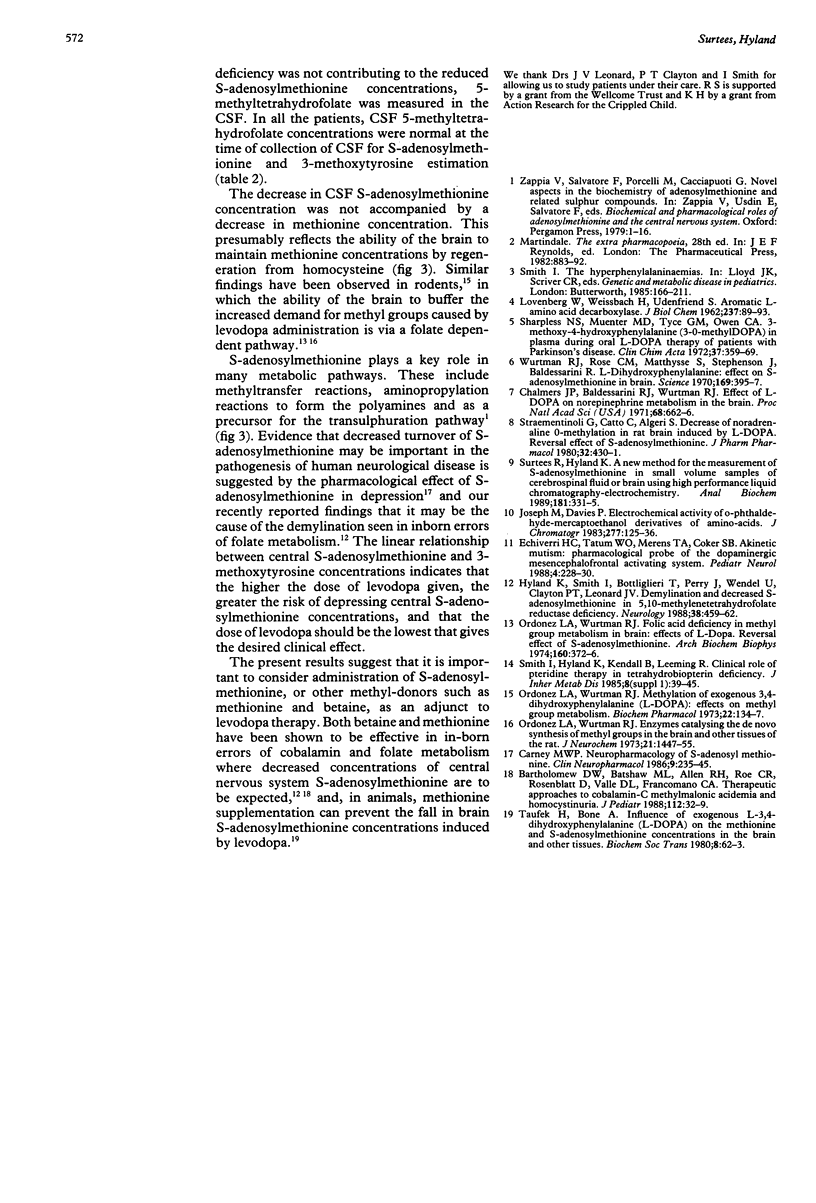Abstract
To determine whether levodopa reduces the levels of S-adenosylmethionine in the human central nervous system, cerebrospinal fluid (CSF) concentrations of S-adenosylmethionine, methionine, 3-methoxytyrosine, levodopa and 5-methyltetrahydrofolate were measured in six children with dopamine deficiency before and after treatment. In four, the lack of dopamine was secondary to a reduction in concentration of levodopa and these were treated with levodopa together with a peripheral dopa-decarboxylase inhibitor. In the other two, levodopa in the central nervous system naturally accumulated due to a congenital deficiency of aromatic-L-amino acid decarboxylase and these were treated with pyridoxine (which in this condition lowers central levodopa concentrations). Raising levodopa concentrations in the central nervous system caused a fall in CSF S-adenosyl-methionine concentration and a rise in CSF 3-methoxytyrosine concentration. No change was observed in CSF methionine concentration and in all patients CSF 5-methyltetrahydrofolate concentration was normal. With one exclusion there was a linear relationship between CSF S-adenosylmethionine and 3-methoxytyrosine concentrations. This is the first demonstration of such effects in humans and the implications upon levodopa therapy are discussed.
Full text
PDF



Selected References
These references are in PubMed. This may not be the complete list of references from this article.
- Carney M. W. Neuropharmacology of S-adenosyl methionine. Clin Neuropharmacol. 1986;9(3):235–243. doi: 10.1097/00002826-198606000-00002. [DOI] [PubMed] [Google Scholar]
- Chalmers J. P., Baldessarini R. J., Wurtman R. J. Effects of L-dopa on norepinephrine metabolism in the brain. Proc Natl Acad Sci U S A. 1971 Mar;68(3):662–666. doi: 10.1073/pnas.68.3.662. [DOI] [PMC free article] [PubMed] [Google Scholar]
- Echiverri H. C., Tatum W. O., Merens T. A., Coker S. B. Akinetic mutism: pharmacologic probe of the dopaminergic mesencephalofrontal activating system. Pediatr Neurol. 1988 Jul-Aug;4(4):228–230. doi: 10.1016/0887-8994(88)90036-7. [DOI] [PubMed] [Google Scholar]
- Hyland K., Smith I., Bottiglieri T., Perry J., Wendel U., Clayton P. T., Leonard J. V. Demyelination and decreased S-adenosylmethionine in 5,10-methylenetetrahydrofolate reductase deficiency. Neurology. 1988 Mar;38(3):459–462. doi: 10.1212/wnl.38.3.459. [DOI] [PubMed] [Google Scholar]
- Joseph M. H., Davies P. Electrochemical activity of o-phthalaldehyde-mercaptoethanol derivatives of amino acids. Application to high-performance liquid chromatographic determination of amino acids in plasma and other biological materials. J Chromatogr. 1983 Oct 14;277:125–136. [PubMed] [Google Scholar]
- LOVENBERG W., WEISSBACH H., UDENFRIEND S. Aromatic L-amino acid decarboxylase. J Biol Chem. 1962 Jan;237:89–93. [PubMed] [Google Scholar]
- Ordonez L. A., Wurtman R. J. Folic acid deficiency and methyl group metabolism in rat brain: effects of L-dopa. Arch Biochem Biophys. 1974 Feb;160(2):372–376. doi: 10.1016/0003-9861(74)90410-x. [DOI] [PubMed] [Google Scholar]
- Ordonez L. A., Wurtman R. J. Methylation of exogenous 3,4-dihydroxyphenylalanine (,dopa)--effects on methyl group metabolism. Biochem Pharmacol. 1973 Jan 1;22(1):134–137. doi: 10.1016/0006-2952(73)90266-9. [DOI] [PubMed] [Google Scholar]
- Ordóez L. A., Wurtman R. J. Enzymes catalyzing the de novo synthesis of methyl groups in the brain and other tissues of the rat. J Neurochem. 1973 Dec;21(6):1447–1455. doi: 10.1111/j.1471-4159.1973.tb06028.x. [DOI] [PubMed] [Google Scholar]
- Sharpless N. S., Muenter M. D., Tyce G. M., Owen C. A., Jr 3-methoxy-4-hydroxyphenylalanine (3-O-methyldopa) in plasma during oral L-dopa therapy of patients with Parkinson's disease. Clin Chim Acta. 1972 Mar;37:359–369. doi: 10.1016/0009-8981(72)90456-1. [DOI] [PubMed] [Google Scholar]
- Smith I., Hyland K., Kendall B. Clinical role of pteridine therapy in tetrahydrobiopterin deficiency. J Inherit Metab Dis. 1985;8 (Suppl 1):39–45. doi: 10.1007/BF01800658. [DOI] [PubMed] [Google Scholar]
- Stramentinoli G., Catto E., Algeri S. Decrease of noradrenaline O-methylation in rat brain induced by L-dopa. Reversal effect of S-adenosyl-L-methionine. J Pharm Pharmacol. 1980 Jun;32(6):430–431. doi: 10.1111/j.2042-7158.1980.tb12959.x. [DOI] [PubMed] [Google Scholar]
- Surtees R., Hyland K. A method for the measurement of S-adenosylmethionine in small volume samples of cerebrospinal fluid or brain using high-performance liquid chromatography-electrochemistry. Anal Biochem. 1989 Sep;181(2):331–335. doi: 10.1016/0003-2697(89)90252-2. [DOI] [PubMed] [Google Scholar]
- Taufek H. R., Bone A. H. Influence of exogenous L-3,4,-dihydroxyphenylalanine (L-dopa) on the methionine and s-adenosylmethionine concentrations in the brain and other tissues [proceedings]. Biochem Soc Trans. 1980 Feb;8(1):62–63. doi: 10.1042/bst0080062. [DOI] [PubMed] [Google Scholar]
- Wurtman R. J., Rose, Matthysse S., Stephenson J., Baldessarini R. L-dihydroxyphenylalanine: effect on S-adenosylmethionine in brain. Science. 1970 Jul 24;169(3943):395–397. doi: 10.1126/science.169.3943.395. [DOI] [PubMed] [Google Scholar]


